|
CD/DVD of the Month:
* HOLLY NEAR: SHOW UP * CALICO TRACKS MUSIC
Other CDs/DVDs Reviewed this Month:
* PATRICIA BARBER: MYTHOLOGIE
* MOZART PIANO TRIOS * THE FLORESTAN TRIO
* VARIOUS OPERA SINGERS: THE MOZART ALBUM
*
AEOLIAH: REALMS OF GRACE, AN ANGELIC EXPERIENCE
*
PHANTASM: JOHN JENKINS, SIX-PART CONSORTS
*
JOYCE DIDONATO: FAUR…/HAHN/HEAD/ROSSINI/HANDEL
* JOAN SUTHERLAND: THE COMPLETE BELL TELEPHONE HOUR
PERFORMANCES 1961-1968
* STRAUSS: ARIADNE AUF NAXOS (Original 1912 Version)
* MICHAEL JONES: ECHOES OF CHILDHOOD

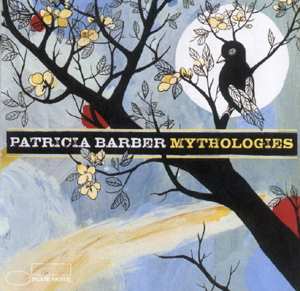 |
PATRICIA BARBER: MYTHOLOGIES *
BLUE NOTE RECORDS 09463 5956429
|
|
0 |
5 |
|
Performance |
 |
|
Sonics |
 |
|
Jazz singer Patricia Barber is her own animal. Just
when you may think that her deep voice is locked in a cycle of unrelenting
coldness, she pens and performs lyrics that sizzle with sensuality. Such is
the case with this all-Barber journey in which ancient gods and goddesses
collide with the mythological sophistication of the jet set and nouveau
riche. Backed by the Patricia Barber Quartet, which includes Barber on piano
and lead vocals, the disc offers a fascinating fusion of ultra-refined
musicianship and uncommon directness. Even on "Persephone," where guest
vocalists and instrumentalists contribute an unmistakable pop touch, the
accompaniment is haunting. Without disclosing exactly what happens musically
on "Orpheus," let's just say that I wondering if I was experiencing yet
another police action on my block or previously unheard sounds from the
smoke alarm.
There are at least two love songs with lesbian
overtones – "Pygmalion" and "Narcissus" – both of which I suspect will
hypnotize people of all persuasions. From such seduction we go to the
unyielding realities of "Whiteworld." ("I arrive in the jungle in my new
khaki clothes * I'm a gangster in a Hummer and this culture will yield to me
*
I like the perfectly primitive cause they desperately need my sovereignty *
and Mother Earth is down on her knees"). Even as we discover that no lyrics
are printed for parts of the equally provocative "Phaeton," we understand
why.
If Patricia Barber takes no prisoners, she also takes
care to uncover pain rather than inflict it. Mythologies'
combination of stunning percussion, penetrating lyrics, and uncompromising
vision deserve the accolade brilliant. Brava to a diva on her own terms. |
|

|
|
MOZART: GREAT AND NOT SO |
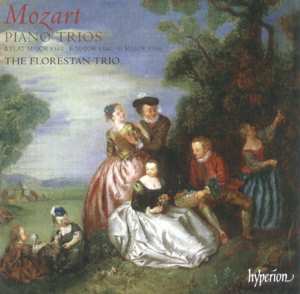 |
|
MOZART PIANO TRIOS * THE FLORESTAN TRIO *
HYPERION CDA67556
|
|
0 |
5 |
|
Performance |
 |
|
Sonics |
 |
|
One of the great bounties of the year long celebration
of the 250th anniversary of Mozart's birth comes from The
Florestan Trio, whose recording of Mozart Piano Trios
proves an unmitigated delight. Although they perform on modern
instruments, pianist Susan Tomes, violinist Anthony Marwood, and cellist
Richard Lester cultivate a lightness of touch that reflects the influence of
early music performance practice. The music is the winner, with the earliest
work on the CD, the Piano Trio in B flat major K502 bubbling over with
refinement and delight. Written in 1786, right after the premiere of Le
Nozze di Figaro, this mature work
treats us to Mozart at his happiest.
High spirits also abound in the Piano Trio in E major
K542, written shortly after Don Giovanni
reached Vienna. Volume and intensity step up a notch in the final movement's
Allegro, providing welcome contrast to the movements that precede it. Then,
in the final work on the disc, the Piano Trio in G major K564's striking
first chord immediately seizes one's attention. With its occasional, brief
peregrinations into sadness and minor keys seeming like clouds passing
briefly over a sunny landscape, this final piano trio in Mozart's oeuvre
simultaneously manages to seem light and filled with import. Mozart
miraculously takes Haydn's elegance and grace to another level, reaching an
astounding level of clarity and joy. |
|

|
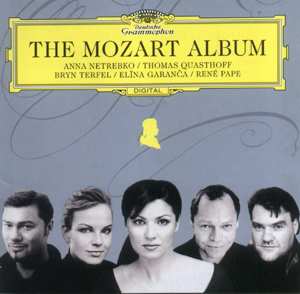 |
VARIOUS OPERA SINGERS: THE MOZART
ALBUM * DEUTSCHE GRAMMOPHON B0006730-02
|
|
0 |
5 |
|
Performance |
 |
|
Sonics |
 |
|
One of the biggest powerhouses in classical recording,
Universal Classics, pulls out all the stops on The Mozart Album.
Featuring a host of big name vocalists, the compilation immediately stumbles
as Anna Netrebko and Claudio Abbado present one of the fastest and least
charming renditions of "Deh vieni, non tardar" on record. Contrast
Netrebko's singing with that of Patrizia Ciofi on RenÈ Jacobs' recent,
award-winning period instrument rendition of Le Nozze di Figaro,
let alone versions from a host of other sopranos, to hear lighter voices
more appropriate for Susannah.
Netrebko thankfully redeems herself in a thrilling,
impassioned version of "Oh smania! Oh furie ä D'Oreste, d'Aiace" from
Idomeneo, and an equally impassioned
duet, "Fuggi, crudele, fuggi!" from Don Giovanni.
But ask her to sound simple, innocent, and/or fragile in the duet "L‡ ci
darem la mano" from the same opera, or in "Zeffiretti lusinghieri" from
Idomeneo, and her singing is
far from ingratiating.
Mezzo-soprano Elina Garanca contributes a potent, rich
voiced "Parto, parto," marred only by an occasional tendency to hit a note
slightly below pitch and then correct it. Bass RenÈ Pape sings a fine albeit
undistinguished "In diesen heil'gen Hallen," more egalitarian than
patrician, that lamentably lacks the low E that Alexander Kipnis and others
have brought to it.
Highest marks go to the great Thomas Quasthoff, who
even in slightly shaky form is a delight, especially in Papageno's bird
handler aria from Die Zauberflˆte;
and to Bryn Terfel, whose "Ho gi‡ vinto la causa!" combines classical
restraint with character galore. Terfel's participation (with Miah Perrson
and Christine Rice) in the exquisite trio from Cosi fan tutte,
"Soave sia il vento" also shows him in softest and most caressing form. If
only Sir Charles Mackerras had conducted this gem one notch slower, allowing
singers more space to float their sound, and us to sink deeper into some of
Mozart's most sublime vocal writing. While Mackerras' performance may never
replace Schwarzkopf and crew's miraculous renditions with Karajan and Bˆhm,
RenË Jacobs' gorgeous recent period instrument version, or a wonderful
English language performance from Eleanor Steber, Blanche Thebom, and
Lorenzo Alvary conducted by Fritz Stiedry, it will undoubtedly have its
partisans. Even when some of these tracks only hint at the glory, they
provide stimulus to search for better. |
|

|
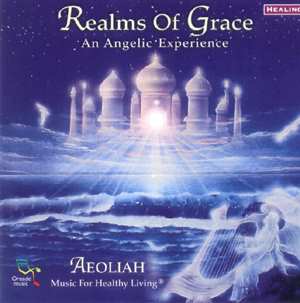 |
AEOLIAH: REALMS OF GRACE, AN
ANGELIC EXPERIENCE * OREADE MUSIC ORM 62752
|
|
0 |
5 |
|
Performance |
 |
|
Sonics |
 |
|
It is time to revise the categories. There is no way to
lump together the celestial music of Aeoliah, Deuter, and other New Age
pioneers with the visionless shlock that so often passes for New Age music.
The term New Age refers to a time in human history – either close at hand or
forever out of reach – when division and war are replaced by unit (the
so-called "thousand years of sisterhood and brotherhood"); it does not refer
to a musical equivalent of Prozac or a modern day Lawrence Welk.
Aeoliah's music is about something far more
transcendent than the Top 40. Realms of Grace's
liner notes include the admonition to play between 13-15 decibels for
optimal results; this renders it far more private than what people blast
from their vehicles these days. A tribute to Aeoliah's classic recording
from the 1970s, Angel Love,
which I found ideal to accompany healing meditations at the former Castro
Street Healing Group, this completion of the Angel Love trilogy is designed
to bring us back to our own inner silence and inner peace. Aeoliah likens
silence to a blank canvas, a place of stillness and receptiveness from which
healing/wholeness can flow. Certainly the peaceful, inner quality of this
magnetic music will prove ideal for meditation, deep relaxation, reiki,
bodywork, and intuitive reverie. Those who may complain that Aeoliah's music
goes nowhere fail to comprehend its essential message: we are already there.
Resisting this truth has gotten us into the global mess we're in. The
transcendent sounds of Realms of Grace
helps us return to what's real. |
|

|
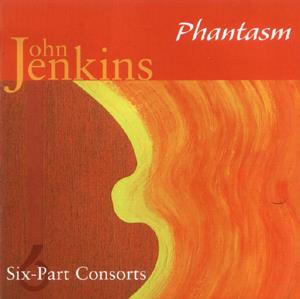 |
PHANTASM: JOHN JENKINS, SIX-PART
CONSORTS * AVIE AV2009
|
|
0 |
5 |
|
Performance |
 |
|
Sonics |
 |
|
Early music ensemble Phantasm, which has already won a
coveted Gramophone Award, here performs six-part consorts by John Jenkins.
Most likely these 12 Fantasys and other works date from the 1620s, when the
long-breathed phrases of English polyphony and the lighter, shorter
statements of Italian Chamber music began to collide. Here, polyphony
triumphs, with six interdependent instrumental lines perpetually dancing and
weaving in, out, and around each other. The music is everywhere tuneful and
inventive; it is often filled with joy. Occasionally Jenkins borrows from
his predecessors, such as in his lengthy reflection on John Dowland's
Lachrymae verae (1599) found in his
Fantasy 5 (not an island).
Phantasm favor a smoother, more even blend in this
music than some players. Unless you pay close attention, you may not want to
take in the entire 16-track disc in one sitting, lest everything seem to
sound alike (which it doesn't). In modest doses, to be sure, Jenkins' music
is a joy. |
|

|
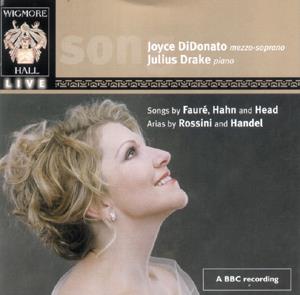 |
JOYCE DIDONATO: FAUR/ HAHN/
HEAD/ROSSINI/HANDEL * WIGMORE HALL LIVE 0009
|
|
0 |
5 |
|
Performance |
 |
|
Sonics |
 |
|
Turning her attention from opera to art song, fabulous
young American mezzo-soprano Joyce DiDonato travels overseas to a fabled
city whose sinking is compounded by rising sea levels. On her new recital
disc, recorded live by the BBC on
January 16, the duration of her visit comes at a happier time in Venice's
history, from 1858 through 1977, when composers as diverse as Giaochino
Rossini, Michael Head, Gabriel Fauré, and Reynaldo Hahn wrote
Venetian-linked romantic serenades.
DiDonato may, like Cecilia Bartoli, excel in the florid
operatic roles of Rossini, Mozart, and Handel, but their voices and
personalities cast very different lights on similar repertoire. Where
Bartoli's larger-than-life presentation of Rossini's three-part "La regatta
veneziana" expresses all the breathless, naÔve excitement of a young woman
rooting for her lover as he competes in a gondola race, DiDonato's vocal
personality offers more weight and less charm. She's certainly more
convincing than soprano Renata Tebaldi, who in a 1965 Concerto Italiano
performance (Renata Tebaldi: A Portrait – VAI DVD) is grand enough to be the
mother of gondolier Momolo, but DiDonato's vocal production is a bit too
rich for Rossini's elementary sentiments.
The mezzo fares considerably better in Fauré's justly
beloved Cinq MÈlodies de Venise,
settings of poetry by Paul Verlaine. DiDonato's "Mandoline" may lack the
ultimate lightness and gaiety that singers as diverse as Ameling and Teyte
have brought to it, but her quieter singing captures a fair share of the
song's specialness. She also produces some lovely, soft singing and subtle
shading in "En Sourdine" (Muted), a song remarkable for the way it melds
love's rapture with twilight's diaphanous mystery. DiDonato certainly seems
to understand FaurÈ's intentions, but she does not yet know how to
communicate the special magic so exquisitely conveyed by Janet Baker's
heart-arresting half voice and Gerard Souzay's caressing sweetness.
Those wishing for the lightness and charm appropriate
for Reynaldo Hahn's Songs in Venetian Dialect,
which he first sang to Madame de BÈarn while playing a piano on a gondola,
surrounded by several other gondolas intentionally positioned where three
canals met beneath three bridges, will have difficulty visualizing the
crowds that spontaneously gathered on those charming bridges and cried out
for more. This is not to suggest that DiDonato is anything other than a
first rank, award-winning vocalist. Her final encore, Rossini's "Non pi˘
mesta" from La Cenerentola,
rivals the finest on record. Her technique is fabulous, her voice stunning,
and the seemingly unbounded visceral energy irresistible. Operatic mastery
such as this, captured in more lively sound than her performance of the aria
on the recent Naxos release of the complete opera, is more than worth the
price of admission.
DiDonato's much-anticipated first outing as Octavian in
San Francisco's June 2007 production of Der Rosenkavalier,
may indeed prove a triumph. She certainly has the range and technique for
the role. Yet as accomplished as she may be, for those oft-illusive, magical
gifts that makes for a mesmerizing recitalist, you will have to turn your
ears elsewhere.
have difficulty visualizing the crowds that
spontaneously gathered on those charming bridges and cried out for more.
Again, this is not to suggest that DiDonato is anything other than a first
rank, award-winning vocalist. Her final encore, Rossini's "Non pi˘ mesta"
from La Cenerentola rivals the
finest on record. Fabulous. More than worth the price of admission. But for
that oft-illusive, magical gift that makes for a superb recitalist, you will
have to turn your ears elsewhere. |
|

|
|
SUTHERLAND AND SILLS AT THEIR BEST
The two greatest operatic experiences of my youth were attending Joan
Sutherland's 1961 Met debut in Donizetti's Lucia di Lammermoor
while still in high school, and attending Beverly Sills' 1971 New York City
Opera performance in Donizetti's Roberto Devereux.
Hence, I jumped at the opportunity to see priceless DVDs of both singers in
their prime years. |
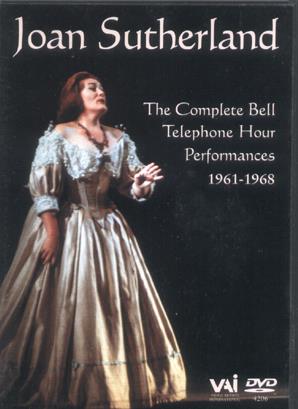 |
JOAN SUTHERLAND: THE COMPLETE
BELL TELEPHONE HOUR PERFORMANCES 1961-1968 * VAI DVD 4206
|
|
0 |
5 |
|
Performance |
 |
|
Sonics |
 |
|
Though sound and picture are not always pristine –
there's audible tape overload in scattered places throughout, and the sound
is compressed for TV – the musical value of the footage trumps technical
limitations.
Vocal limitations were never a concern at the start of
coloratura Joan Sutherland's international career. Heard in the 14 scenes
and arias that she performed on the Bell Telephone Hour during her prime
years, the voice is everywhere secure and magnificent.
The first two selections, 1961's Mad Scene from Thomas'
Hamlet and the "Willow Song" from
Verdi's Otello (devoid, alas,
of the "Ave Maria"), find La Stupenda
in brightest and clearest voice. These early, elaborately staged
performances allow us to hear Joanie before her desire to add roundness to
her innately bright sound resulted in increasingly mealy-mouthed
enunciation.
Costumes, gestures, and movements are, to judge from
old photos and artwork, authentic to the period if nonetheless overly
stylized and stock.
Once you get past Sutherland's tendency to move like a
heavyweight ballerina and continually cock her head back in order to spin
her high notes with ease, you're left with some of the finest, most
thrilling coloratura displays you will ever encounter. Yes, the voice is
captured best on LP/CD, but they're devoid of the Bell stage settings, some
of which are a hoot.
Donald Voohees and the Bell Telephone Hour Orchestra
are hardly the subtlest of partners, but La Stupenda
knows how to get past such stumbling blocks to grace her singing with always
musical rubato, superb
embellishments, and thrilling high E flats. Even if one tires of the same
shtick in scene after scene, and cannot help noticing that Joanie would have
served Tosca best by leaving
it to Callas, Sutherland's vocalism is in a class by itself. |
|

|
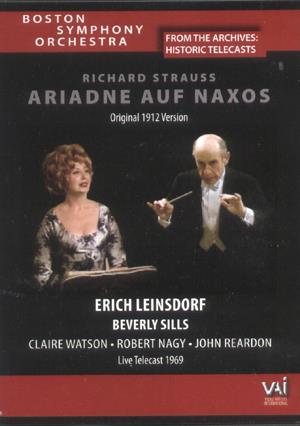 |
STRAUSS: ARIADNE AUF NAXOS
(Original 1912 Version) * VAI 4363
|
|
0 |
5 |
|
Performance |
 |
|
Sonics |
 |
|
I couldn't believe the news. A DVD featuring Beverly
Sill's fabled performance of the torturously difficult, original 1912
version of Zerbinetta's aria from Richard Strauss's opera, Ariadne auf
Naxos, had just been released by VAI! I
immediately dispatched an email to the label, proclaiming that if they did
not send a review copy forthwith, there was a great likelihood that I would
die from anticipation.
This DVD preserves the Boston Symphony Orchestra's
January 7, 1969 concert presentation of the original 1912 version of
Strauss's delightful opus. The performance was originally telecast live in
living color on the WGBH network. Not since the Cleveland Orchestra issued
Sills' December 28, 1967 concert performance of Handel's Semele
in its 2004 four-CD box set, The Robert Shaw Legacy (1956-1997),
have Sills lovers had it as good.
Almost. While color and focus are excellent, cameras
seem to have been located far from the stage, with facial close-ups beyond
the director's capabilities. The overall effect, compounded by a recording
in which voices lack the clarity and focus of the instruments under Erich
Leinsdorf's direction, distances viewers from the heart of the experience.
Still, Sills is a marvel. Less than three years after
her assumption of the role of Cleopatra in New York City Opera's production
of Handel's Julius Caesar belatedly
catapulted her to international stardom, the almost 40-year old diva tosses
off most of the high Fs in Strauss's impossibly long original version of
Zerbinetta's tour-de-force with aplomb. Smiling through the bulk of the
performance, appearing unbelievably at ease in an aria that Strauss later
shortened and lowered a whole step because of its difficulty, she
demonstrates why the woman from Brooklyn born Belle Miram Silverman was
affectionately known as Bubbles.
Yes, there is occasional evidence of the spreading
vibrato, hastened by Sills' assumption of the role of Queen Elisabeth in
Donizetti's Roberto Devereaux the
following year that signaled Sills' decline in the '70s. But for 98% of the
performance, the dazzling lightness, iridescence, and accuracy of Sills'
mesmerizing high range transcend all criticism.
As for the rest of the cast, handsome John Reardon's
well-sung Harlekin and the three Nymphs of Benita Valente, Eunice Alberts
and Carole Bogard stand out. Although the under-recorded Claire Watson does
not offer the most alluringly voiced Ariadne on record, her passion,
commitment, and strong high range win deserved cheers. Andrew Raeburn
promises surprises when he appears to speak the part of M. Jourdain.
The chance to see/hear the American premiere of
Strauss's first version of the opera should not be missed. You'll find no
trace of the final 1916 version's 40-minute Prologue; Hugo Von Hofmannsthal
had yet to create the role of the Composer. Though the libretto and plot
development prove less compelling than in the later version, the chance to
hear Sills sing additional music for Zerbinetta that Strauss later excised
provides significant compensation. As for Bubbles's black and white
patterned dress, big red hair, and floppy curls, words cannot begin to tell
the tale. |
|

|
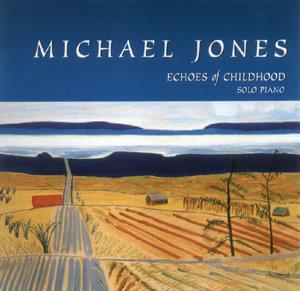 |
MICHAEL JONES: ECHOES OF
CHILDHOOD * NARADA 83040
|
|
0 |
5 |
|
Performance |
 |
|
Sonics |
 |
|
Michael Jones's first CD, Pianoscapes,
was the Narada label's first release in the prophetic year of 1984. Narada
has since grown into a major presence, while Michael has produced an
additional 13 well-selling albums while becoming a respected presenter of
leadership seminars.
Michael Jones is certainly not out
to tax your mind or stretch your boundaries with his music. His consistently
lovely, non-stop lyricism, evident on every track of his Echoes of
Childhood, reflects a timeless
spirit light years away from the post-Orwellian falsehoods that would
enslave hearts and minds in the name of ephemeral security. The disc's waves
of gentle melody simultaneously resonate in the present moment and reach
back to a time of unspoiled purity. If there are revelations to be had, none
can be more profound than the awareness that beauty births unchecked amidst
fear and fascism. |
|

|
|
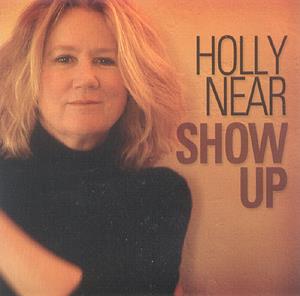 |
HOLLY NEAR: SHOW UP * CALICO
TRACKS MUSIC
|
|
0 |
5 |
|
Performance |
 |
|
Sonics |
 |
|
Holly Near has been singing of life, love, and freedom
for a good 30 years. Now 57, and recently back from performing at the Gay
Games in Chicago, she continues to share messages of social change,
feminism, gay & lesbian freedom, and the joy of life with a freshness of
voice and spirit that bring a smile to one's face and a fist to one's hand.
Life isn't a simple case of black and white, and Holly Near doesn't pretend
otherwise.
Performing in a variety of styles, including
rockabilly, rock, and classic folk, Holly knows how to mix humor and
showmanship into her songs. My husband just ran down the stairs, grabbed me
in the middle of the fabulous title song, "Show Up," and spontaneously
danced me around the room. Such is the power of Holly's invitation to show
our beliefs rather than sitting on them. After that great song comes another
Near original, the plaintive and haunting "It's About Time." Next follows
her unique arrangement of "Drunken Sailor," unexpectedly powerful thanks to
new words that bring home the pain of addiction and Jackeline Rago's
arresting percussion. Other standout tracks include Holly's unforgettable,
anthem-quality "Somebody's Jail" and "I am Willing" ("So lift me up to the
light of change"), a sweet cover of Cheryl Wheeler's heart-opening
"Gandhi/Buddha," and a driving rendition of Jackson Browne's "Lives in the
Balance." This is a great, spirit-enriching album. |
- Jason Victor Serinus
-
Terms and Conditions of Use
|